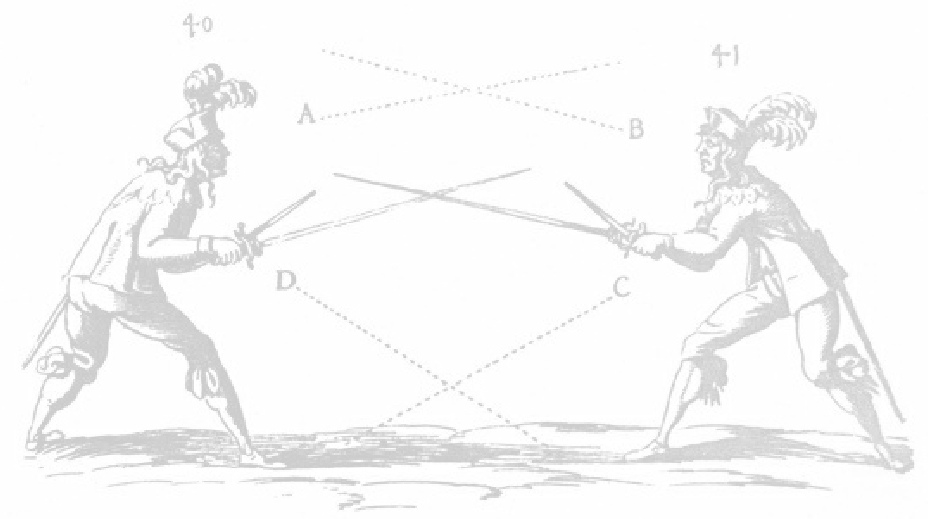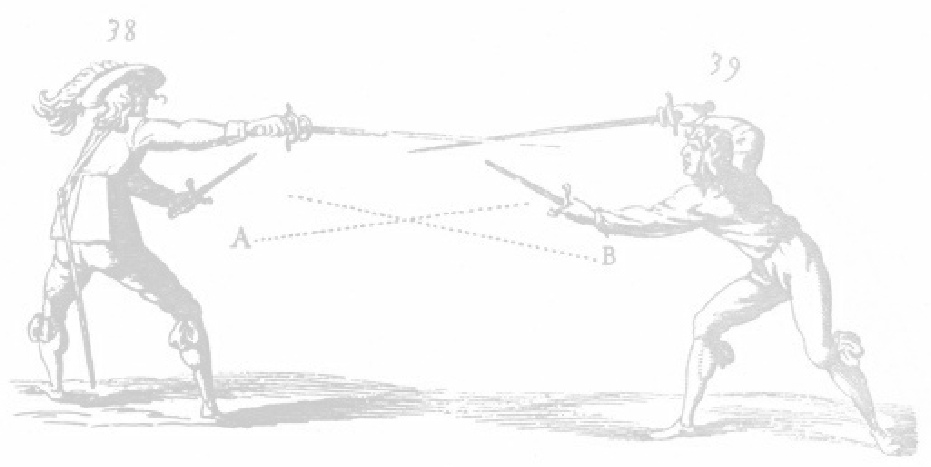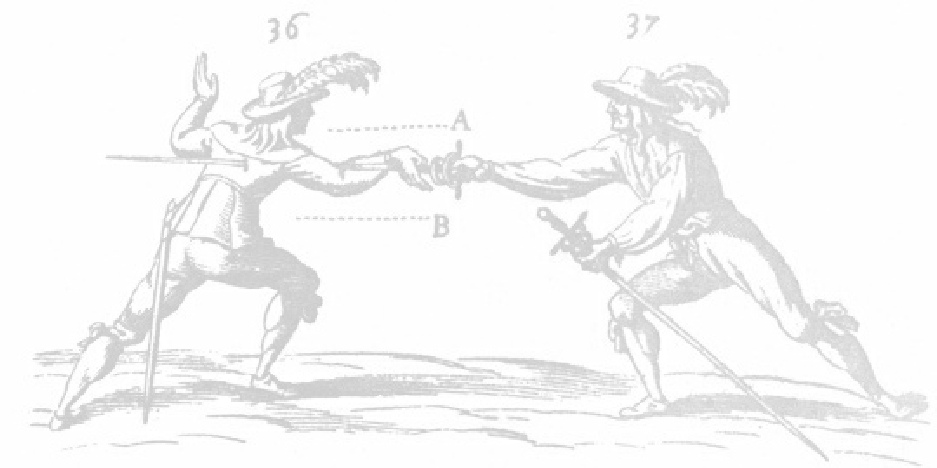




Some Thoughts on the Mental Aspects of Fencing 2
The easiest way to “act out” this alertness is the manner in which you come on guard. When in guard you should be
- Still
- Relaxed
- Balanced
- At a safe measure
- Your sword should be in presence, or at least threatening your opponent.
- You should be looking at your opponent, but not staring – you need your peripheral vision to check for other threats.
In some sense you are “suspicious” of what is going on around you – you do not trust that you are safe, rather you assume that there are threats (known or unknown) and prepare to deal with them. You must, as best you can, control the situation and space around you. Even when facing off against a single opponent, you should be wary of what is going on around you – they may have friends!
In ideal terms you need to make sure that as soon as you are stepping out to work with a partner, whether it is for an exercise or a competitive bout, you are ready to fight. You should keep a safe distance from our opponent and form a guard outside of measure.
Simple points to consider include:
- You should not be stepping out to do the exercise while we are still getting dressed/ fixing kit etc.
- Once you are in guard you should be settled – there is no need to keep adjusting or shifting around.
- Try to avoid spending lots of time checking or adjusting the measure if it is a “static” drill
- Avoid posing for the camera
- Remember to fly out to a good guard after every phrase
- If you are repeating an exercise, move from your guard (from flying out) to your next guard (to begin the exercise) with as few steps/movements as possible.
- Maintain alertness – don’t relax between every technique.
Focusing on performing the basic physical actions well and consistently forms part of a positive feedback loop, removing distractions and reinforcing your positive mental state.
You also need to practice mental skills in the same way that you would practice cutting. For example, drills to improve visual acuity and judgement include:
- Judging measure – practice moving to a point just inside or just outside measure, without using blade overlap as a guide
- When watching your opponent, try looking for specific, subtle movements, such as where is their weight? Where is the strength on their guard? Where are they looking? (Having done this exercise you should find that your general awareness increases. This exercise also forms part of a refocusing plan, see below.)
In the same way that you need a plan to reach your desired level of focus before
a fight, you should have a strategy to regain your focus if you become distracted
in the fight. This is called a refocusing plan. Your refocusing plan can include
pre-
If you use imagery or simulation (too detailed to cover here) as part of your training,
your pre/on-
Everything we have looked at so far is about improving your own game – avoiding mental distraction so that you are better able to observe your opponent, defend yourself effectively and take advantage of any opportunities that your opponent presents to you.
The final pat of this discussion is the psychological interplay between yourself and your opponent, particularly the state of obedience.
If you are in obedience, then you are acting through need and not through choice. The most common “obedient” action is the parry – moving to defend yourself because you fear being hit, rather than to take control of the situation and hit your opponent. If you are put into obedience, then your opponent can control the fight and deceive you with feints. Fabris goes as far as to counsel against parrying so as to avoid going into obedience. However, he also notes that parrying does not have to be obedient, as long as you are choosing what to do and keeping the pressure on your opponent by counter attacking as well (or at least threatening the counter attack).
Obedience and fear of your opponent’s sword have the biggest effect on your techniques. If you do not commit to your feints or attacks you can be hit easily in contra tempo. If you never attack, then your opponent can attack when they choose with no fear. Therefore you must learn to avoid obedience and, where possible, put your opponent into obedience, encouraging them to lose the fight in their head. As an example, watch a student fight a student of a lower grade and then fight an instructor; the difference in their actions is often quite startling.
Obedience can be one of the hardest things to simulate in training, because, ultimately, there should be no real threat in the bout. It is, however, useful to train with obedience. Ways to simulate it include:
- Penalties, e.g. press-
ups, for being hit - One hit and off style bouts
- Fencers’ pride!
- Use of imagery/simulation
Avoiding obedience can be challenging, although forming a strong counter posture as described above is a good start. However, if you believe you are going to lose the fight, or fear for your life, then you will communicate this to your opponent and strengthen his position over you, thus making it more likely that he will hit you.
This is because the psychological interplay between yourself and your opponent is
often based on very subtle physical clues and non-
As before, whatever our actual mental state may be, all we have to do is send the right physical signals to our opponent to achieve the desired reaction. The more you can genuinely achieve the better – those you cannot, you need to simulate as best you can. Imagining that you are strong and acting as if you are stronger than your opponent will help to send the right signals to your opponent to put them into obedience (avoiding the reverse) and make your techniques more successful. This will then encourage a positive feedback loop and reinforce your dominance over your opponent in their head. This is why top fighters often appear quite arrogant!
In an effort to avoid obedience, both Italian and Japanese cultures include sayings about not fearing death, or considering oneself already dead before the fight. Ironically, one must be prepared to die in order to avoid the reactions that will create the greatest threat to your life!
The psychological interplay between you and your opponent is similar to a bind with the sword. If your opponent is “weak”, you need to be strong and put them into obedience. If your opponent is strong, then you can appear weak and then strike your opponent as they try to attack.
As an aside, some treatises discuss distracting an opponent, but I believe that distracting a good fighter is difficult to do. I am wary of movements that are designed purely to distract an opponent, simply because they may also distract me, and can be a waste of energy for no return. An example of this is the use of the cloak: flicking the cloak at your opponent may distract them, but if you are thinking too much about flicking the cloak, you are not thinking about defending yourself or hitting your opponent.
In summary, like the physical actions of swordplay, the mental side is first based on your own defence – avoiding external distractions and not allowing your opponent to control the fight. If you can achieve this, then you have a good base from which to “persuade” your opponent that you are in control of the fight and helping them to lose the fight in their head. Like swordplay, first form a good mental counter posture and then proceed with resolution.
(c) The School of the Sword 2009 : The School of the Sword is a Western Martial Arts school providing lessons in sword fighting and Historical European martial arts in Berkshire/Surrey UK